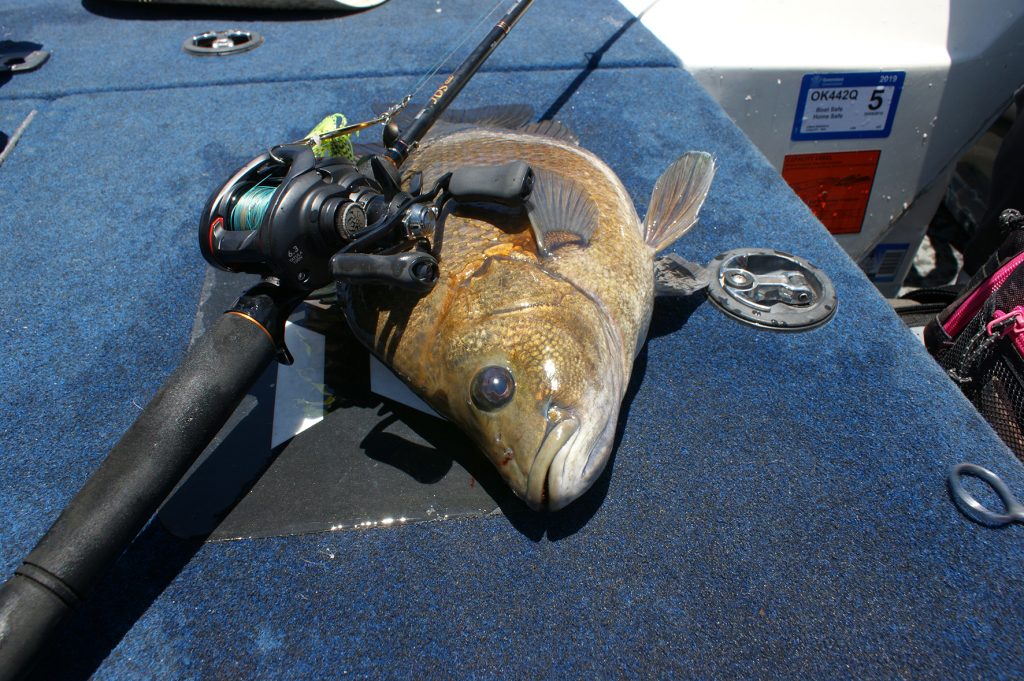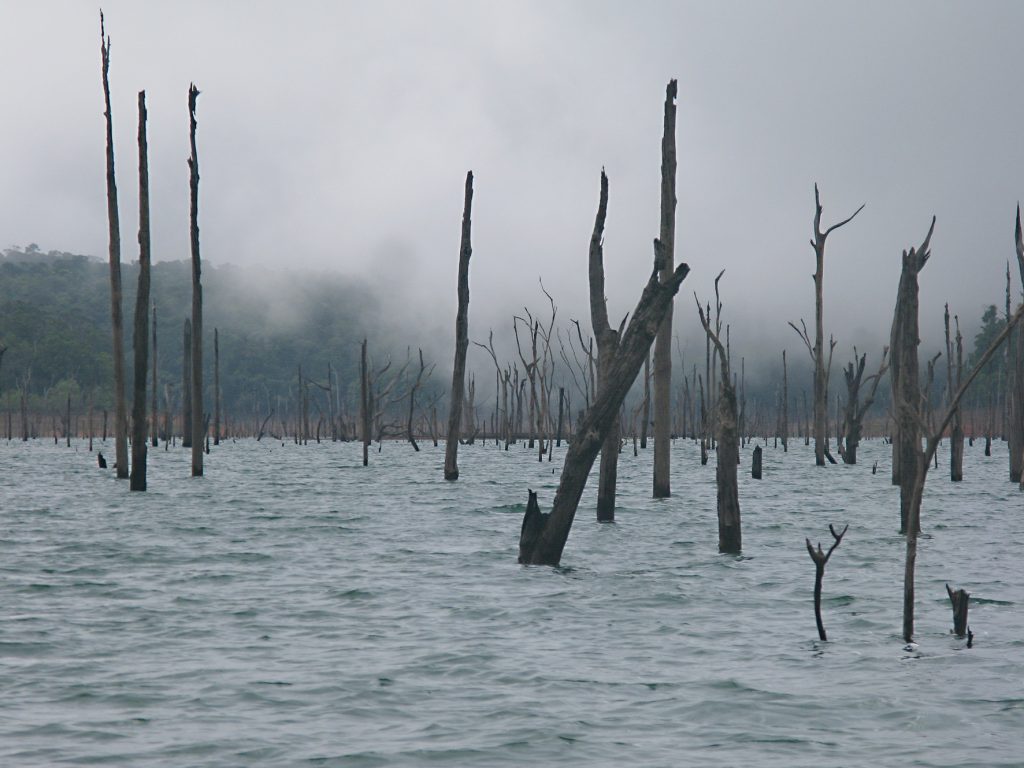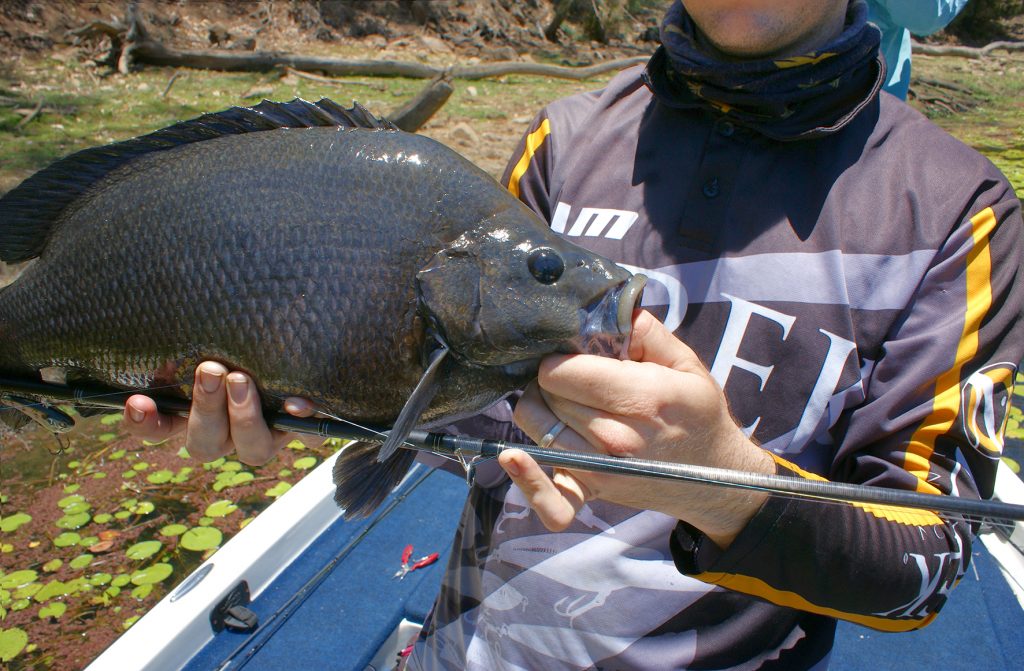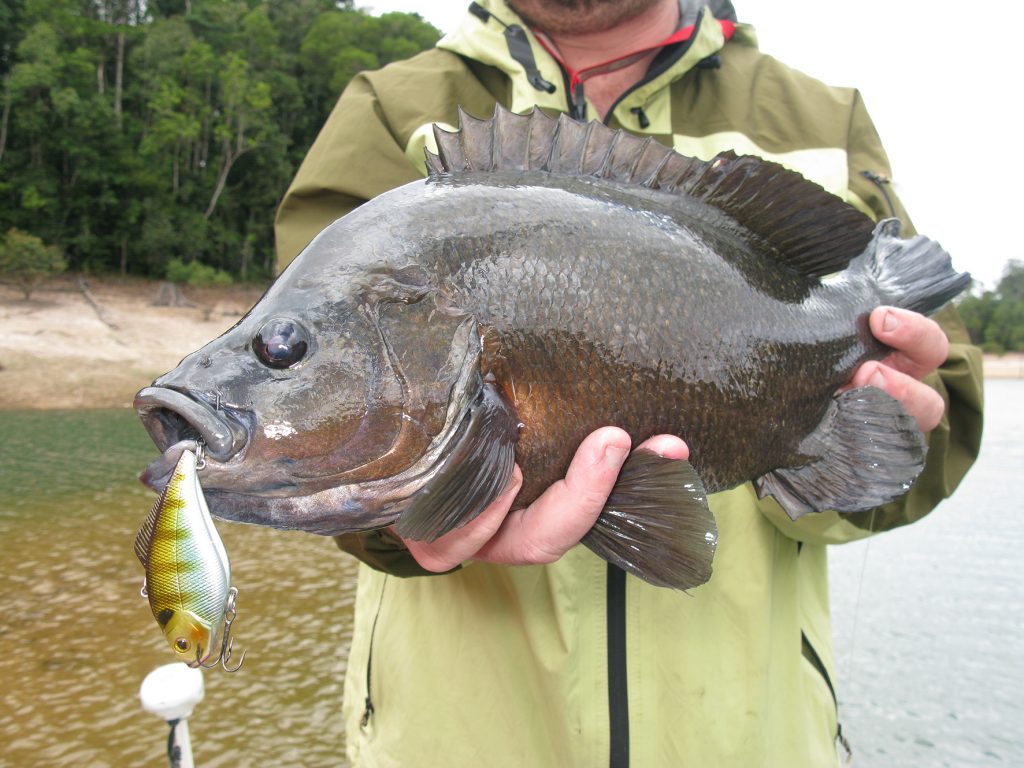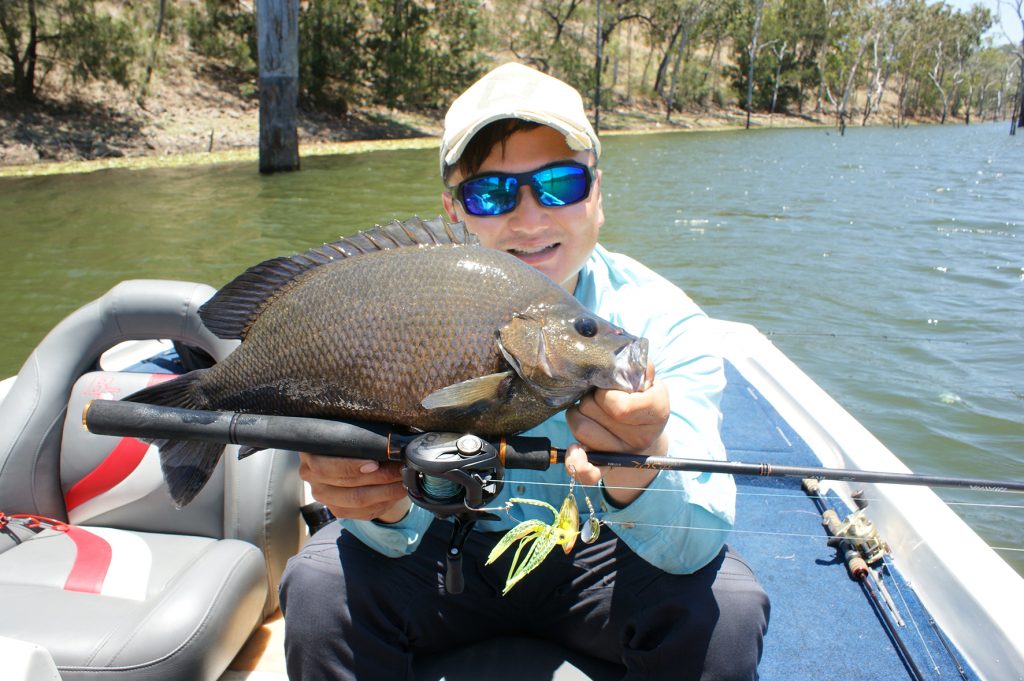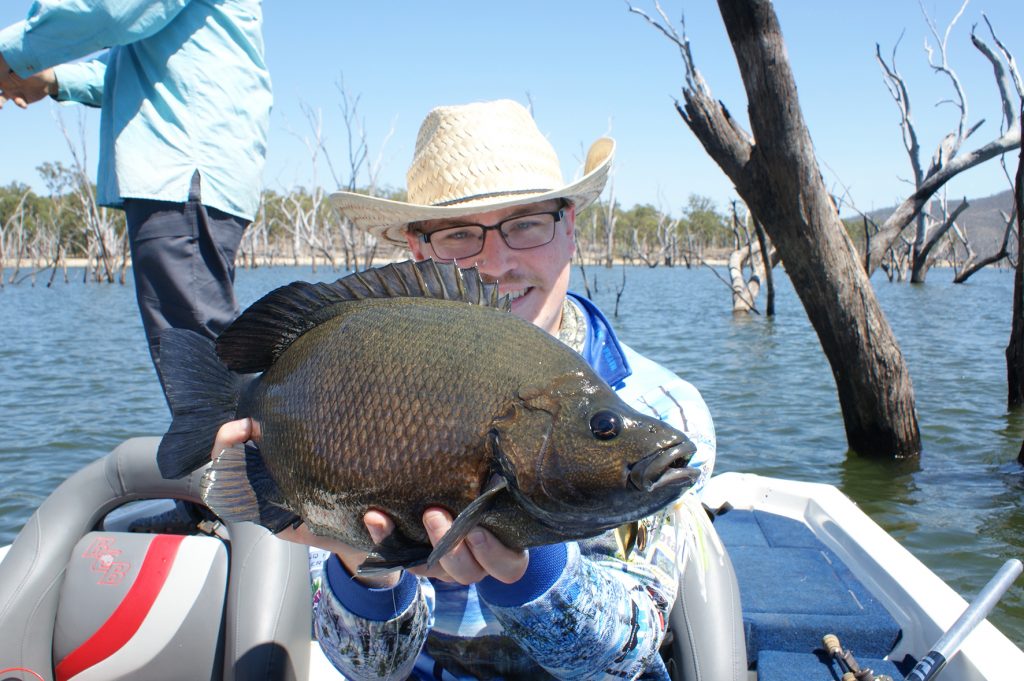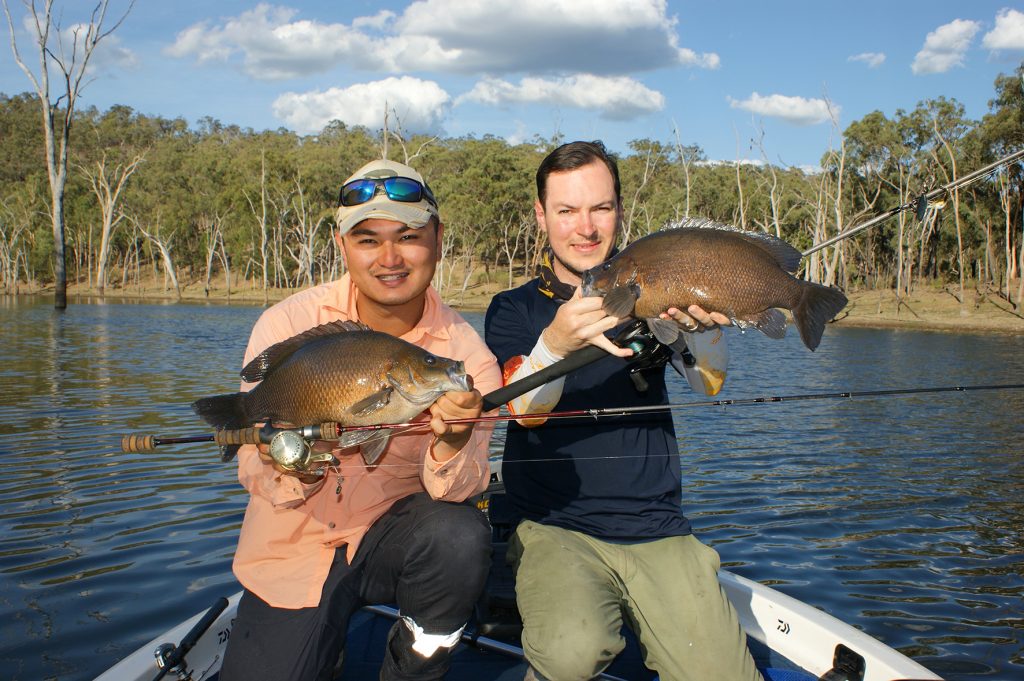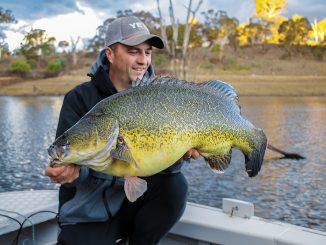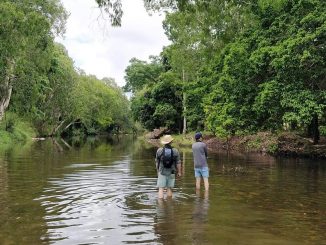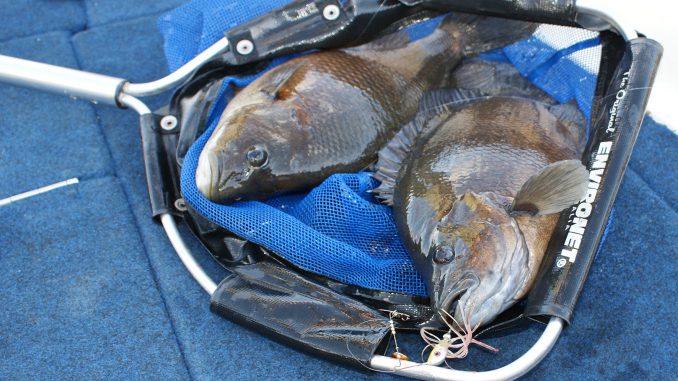
by Bob Thornton •
If you’ve ever travelled north into the tropics of Australia, or you’re lucky enough to live in this amazing part of the country, you will have at least heard of sooty grunter. Often overlooked as a sportfish, even by the travelling anglers, these hard-fighting balls of pent-up aggression are a fantastic target, and deserve to be treated as such.
THE UNDERDOGS
There are many reasons that sooties, at least in my opinion, don’t receive the admiration they deserve. One of the main reasons is that they are relatively common, inhabiting the freshwater reaches of many tropical rivers, and a quick look at a map of the north coast will show you just how abundant flowing freshwater is in this area.
Another reason sooties are dismissed is that in their natural habitat they are fairly small, rarely exceeding about 40cm. However, what they lack in size they more the make up for with their fighting ability, employing the gutter tactics akin to other dirty fighters like mangrove jacks.
The final characteristic that I believe does sooties a disservice is the fact that when you find good numbers of wild specimens, they can be near suicidal! Quite often anglers can have multiple quarrelsome ‘soots’ shouldering each other for a lure or fly, and catching two fish on one presentation is not uncommon at all. This is fantastic fun, and I will always enjoy catching wild sooties, but many anglers tire of the lack of challenge involved.
A DAM GOOD SOLUTION
A solution to these so-called ‘problems’, which addresses the three areas I’ve highlighted, is to fish for them in stocked impoundments! Impoundments with sooty grunter as the dominant species are few, but the fish in them can grow to be 60cm and upwards of 4kg, and the tactics involved to catch them are different to those in creeks. It’s almost like fishing for a different species! I’ve learnt just about everything I know about dam sooties from Daiwa’s Simon Goldsmith, and before my first trip up to Eungella Dam a few years ago, he eagerly drew me up a mud map of places to try and gave me plenty of advice on what lures to use. I could tell I was in for a treat!
Sooties are stocked as the primary predator in only a few dams, and the most well known are Eungella Dam near Mackay, Koombooloomba Dam near Tully, and Lake Julius near Mt Isa. Many dams better known for their barra fishing also have sooties stocked, such as Peter Faust Dam near Proserpine, Tinaroo and Copperlode dams near Cairns, and Lake Moondarra near Mt Isa. These latter waterways can provide excellent sooty fishing opportunities as well, however anglers will need to forget the barra, downsize their gear and specifically target the soots – I’ll admit, this isn’t always easy!
Sooties are also known to turn up in smaller, private landlocked waterways, such as farm dams and mining storages. They end up in these places either by stocking, or if they are endemic to the system prior to its being dammed, and will breed if granted access to flowing water. Getting into and fishing these locations is hard, particularly if you don’t know any farmers up this way and don’t work in the mining industry, but it always pays to ask the locals and keep your ear to the ground; you might just find your own pond full of 4kg sootballs!
As a quite aside, I believe that if the controversial Urannah Dam project west of Mackay goes ahead, this waterway will most likely become a sooty Mecca! It will be very interesting to see what happens.
PREPPING FOR DITCH PIGS
Access
Before you get after these fantastic sportfish, it’s important to get yourself set up.
In major impoundments, access for vehicles and vessels isn’t usually a problem, with Eungella, Julius, Koombooloomba, Peter Faust, Tinaroo and Copperlode dams providing adequate facilities. A 4WD, while not necessary, is preferred, with Eungella and Koomboolomba both only accessible via a long stretch of intermittently graded dirt road.
Of course, boats and kayaks aren’t the only way to get into these waterways, and bank access, if possible, can provide some good angling opportunities. In the smaller, private land-locked waterways, bank angling may be the only way to fish it.
Artillery
The gear for dam soots is an interesting one. While a sooty is about on par with a bass of the same size in terms of power and stamina, dam sooties can regularly reach weights of 3.5kg and more! This means that if you’re a southern angler, your regular bass gear may have to be scaled up a bit.
This really is the realm of baitcast tackle, and unless you’re throwing anything lighter than 7g, I wouldn’t bother using spin tackle. Nothing beats the accuracy and control an angler can achieve with a sturdy baitcast rig. There is a time and a place for spin tackle in sooty dams, but most of them time the fish are aggressive enough that it’s just not necessary. However, if you’re more comfortable with a spin rod,
While 2-5kg rods and 2000-3000 size reels will get the job done on most dam sooties, the 4-6lb braided lines we use for bass won’t stand up to the structure-orientated hand-to-hand combat you run into with sooties. I would recommend using 10lb braid as a minimum, if using braid. As for leader material, 12lb fluorocarbon or mono is fairly standard, however an upgrade to 15lb may be in order if you’re chasing the bigger models around heavy cover.
If you’re a fly angler, an 8wt is perfectly suited to this caper. Lighter outfits will still subdue big sooties, however in this give-no-line territory, the 8wt will give you the perfect balance between comfort and pulling power.
Lures
Most lures between 40-100mm will work on sooties, however there are a few specific lure types that you shouldn’t venture to a sooty dam without.
Without a doubt, one of the most effective weapons for soots is a spinnerbait. I like to carry a range of spinnerbaits between 1/8-1/2oz, in a variety of colours and blade configurations.
Crankbaits, being so good around timber and rocks, are another incredibly effective lure. Different diving depths, colours and sizes will maximise your options.
Lipless crankbaits, just as in bass impoundments, are fantastic searching lures, as they can be cast far, worked quickly, and sunk to the desired depth.
Jerkbaits become useful when the reaction bite slows down, and the sooties aren’t quite so charged up. In a similar way, lightly-weighted soft plastics are handy for slowing down and employing a bit of finesse. Sinking stick minnows are very enticing to a more weary sooty, however being a sinking lure (and usually expensive) the user must be careful when fishing them around structure.
A variety of topwater lures will come into their own when the light gets lows and the sooties venture out of the junk. A mix of topwaters that can be fished slow and fast will again maximise your options, and models that can be worked through timber, brush and weed, such as buzzbaits and hollow-body frogs will round out the collection and ensure that no sooty is safe!
Something to consider is that sooties have really tough and munchy jaws, and like to roll and twist during the fight, and this can be damaging on light-gauge hooks or spinnerbait wire. Upgrading sub-standard hooks and sticking to good quality spinnerbaits will see less fish lost due to tackle failure.
A sooty will eat just about anything, particularly a big sooty, but finding the right lure for the situations presented will make sure you get the most out of your fishing.
YEAR ROUND SOOTIES
You can target sooties in dams all year round, and travellers need not worry about waiting for the ‘right’ time of year to take on the challenge. The only constant through the year is that your casting needs to be accurate, as these are very structure-orientated fish. These two reasons, and the fact that they are really chunky fish, are why impoundment soots are such a great sporting proposition!
Summer
Summer usually sees the sooties feeding hard during the lowlight periods, while taking shelter in structure or deeper water during the day. Summer in the tropics can often see big rain events, and a sharp rise in the water level can often prompt sooties to feed in amongst flooded vegetation, just like trout and bass down south.
Topwater fishing is a bonus of warm summer mornings and afternoons, making this time of year a fun time to hit the dams in search of sooties.
A variety of reaction lures, with some finesse presentations for when the bite slows down during the day, will be enough to see you through a summer sooty session on the dams.
If sooties have access to flowing water above the dam, they will venture upstream during summer to breed. During this time, anglers can go into the headwaters on foot and experience some excellent fishing. Before the first big wet weather event, the sooties will often stage higher up in the dam, waiting for the first opportunity to push up into the flowing water. It’s for this reason that summer offers the toughest fishing (if you could call it that) of the year.
When the fish are clustered like this, is pays to search around a bit, and when you find fish, work the area over thoroughly and you’ll likely score big!
Autumn
Autumn is a great time to be fishing for sooties anywhere. The dams are usually still benefitting from wet season run-off, which usually gets the fish active, and the temperatures are fairly comfortable, meaning you can fish all day.
Lowlight periods will be the best times to fish, however with the sweltering heat of summer gone, the fish will feel comfortable feeding higher in the water column.
One quirk that sooties have in impoundments is their strange habit of feeding around deep, drowned timber, particularly in the cooler months. Some of the trees can be in as much as 80 feet of water! What makes it so interesting is that the sooties will often only be in the first 10 feet of the water column. An effective way to fish for these fish is to cruise through the forests of good timber with reaction style baits, such as crankbaits and spinnerbaits, throwing quick, but accurate casts into the forks of the trees, and not wasting too much time allowing the lure to sink or sit in the strike zone. If a sooty is home and hungry, it will dash out and claim your offering. When the technique was described to me by someone far more experienced than I, they said “pick a group of trees, cruise through them – any tree is a good tree – and only throw 1-2 casts at each tree before moving to the next one.”
If this isn’t working, it’s probably best to move to shallower bankside structure and work the areas over with a variety of lures, making sure that you keep moving, and don’t spend to long working an area over.
Winter
Winter can be a truly magical time to be in the hinterland chasing ditch sooties. Amazingly, some of our more upland sooty dams such as Eungella, Koombooloomba and Tinaroo can have some near 0°C mornings during winter!
Winter, unlike for many other species, is not the time to be packing away the gear. The warmth of the sun during the day seems to bring them on the bite, and the deep timber technique mentioned above really shines in winter. The timber near the surface will hold onto the heat of the sun, meaning the sooties don’t only get shelter, but also precious warmth. In these conditions they need not dive down deep for sanctuary.
Toward the afternoon they will often move up onto really shallow areas, such as flats or shallow weedbeds, all the while sticking close to any nearby structure. The fish can quite easily be coaxed out to attack a lure by casting accurately and a working your lure a little slower.
Winter may demand the need for slower presentations, as the fish might not be as active as in the warmer months, but they still have the need to feed. On top of that, with so many other sooties feeling the same need, it’s eat or starve in this world. In short, they are less active, but just as hungry, much like bass at this same time of year.
Where fast presentations work better in the warmer months, slower presentations such as jerkbaits, soft plastics and reaction baits retrieved slowly will often yield better results in the cooler winter conditions, but this, like everything else, is not a hard-and-fast rule.
Camping up in these more upland dams during winter is wonderfully comfortable in comparison to the warmer months, as there’s no violent storms or intolerable heat to contend with. Winter is certainly the pick for many seasoned dam sooty tragics!
Spring
Spring can be quite a dry time in the north of Australia, but generally offers comfortable temperatures and stable weather. While the sooty fishing is not at its peak in the dams, spring certainly makes for some great camping weather.
This time of year can see the fish in a transitional stage, where they’re looking to move away from the deeper structure and start heading up the tributaries.
If the summer storms arrive early and dump in late spring, you can expect the fish to be up higher in the dam, but if it remains dry, the fish should be concentrated in the lower part of the dam.
A good mixture of reaction baits should be enough to fool any sooties you find, and later in the day you can expect some explosive topwater action as well.
WHO’S LOVIN’ SOOTS?
Hopefully I’ve highlighted why people should be celebrating these incredible fish. The only way for you can fully appreciate this great resource is by packing up the gear and making a trip to your nearest ditch full of pigs!

